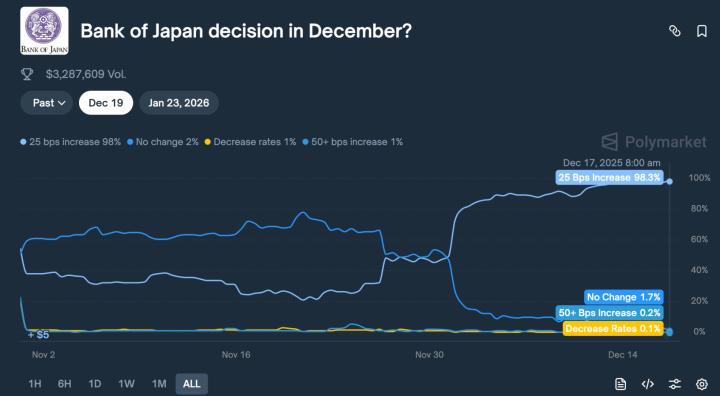Key Points
Global Macroeconomic Drivers: Important economic data in April (employment, inflation, GDP) and central bank decisions will significantly impact cryptocurrencies, as digital assets are now highly correlated with overall risk sentiment.
Central Bank Policy Trends: Many central banks are moving towards easing policies or maintaining interest rates, which typically promotes risk appetite, benefiting Bitcoin and major Altcoins.
US "Tariff Liberation Day": On April 2nd, the US will announce new tariff measures. Severe tariffs may trigger risk-averse sentiment, while moderate policies could boost market mood.
Market Volatility Key Windows: Crypto traders should focus on April 4th, 10th, 16th, 17th, and 30th, as economic data and policy signals on these days may cause market turbulence, and risk hedging strategies should be prepared in advance.


Image Credit: Economic Calendar
April 9 - Federal Reserve (FOMC) Meeting Minutes
The Federal Reserve did not have a monetary policy meeting in April. Traders will closely monitor the March meeting minutes to understand officials' views on inflation and economic risks. If officials lean towards further tightening, the market may readjust its rate cut expectations. Cryptocurrencies typically perform better under expectations of monetary policy easing.

Image Credit: Inside the Hood
April 10 - US Consumer Price Index (CPI)
US inflation data remains a key indicator. The year-on-year increase in February was moderate at 2.8%, providing space for the Federal Reserve to pause rate hikes. However, if March inflation data shows a rebound, it may weaken market expectations of near-term rate cuts. The crypto market typically benefits from ample liquidity, and crypto asset prices will become more volatile if the market fears policy tightening.

Image Credit: Economic Calendar
April 30 - US Q1 GDP and Core PCE
The initial US Q1 GDP value and the core Personal Consumption Expenditures Price Index (PCE), which the Federal Reserve closely monitors, will be released at the end of April. If GDP data is weak, the market may again worry about recession risks, and the Federal Reserve's dovish view may be further strengthened. Additionally, if core PCE shows weak inflation pressure, the market may bet on rate cuts in advance. These data will have a decisive impact on the Federal Reserve's policy decision in early May and drive crypto market trends.
(Translation continues in the same manner for the entire text)Bank of Canada (BoC) – April 16
The Bank of Canada has lowered its interest rate to 2.75%, with an anticipated further reduction to 2.50% in April. This dovish policy reflects the global central banks' trend towards easing, which is favorable for the crypto market.

Image Credit: Economic Calendar
OPEC+ Meeting – April 3
The Organization of the Petroleum Exporting Countries (OPEC+) will meet on April 3 to discuss production policies. If they decide to cut production, oil prices may rise, increasing inflationary pressure; if production levels are maintained or increased, it could help control inflation, creating conditions for central banks to maintain loose monetary policies, which would be beneficial for the crypto market.

Image Credit: Leadership.ng
IMF and World Bank Spring Meetings – April 21-23
Finance ministers and central bank officials from around the world will gather in Washington to discuss global economic growth prospects. The IMF may adjust its economic growth forecast. If the prediction is pessimistic or warns of trade and debt risks, it could negatively impact the market; conversely, if it signals stable economic growth, it will be favorable for market risk sentiment.

Image Credit: Pakistan & Gulf Economist
Crypto Market Dynamics: Key Considerations
Inflation and Interest Rates
When inflation remains moderate, central banks have room to lower rates or keep them unchanged, which is typically favorable for cryptocurrencies. However, if inflation unexpectedly rises, central banks may tighten policies, which would be detrimental to Bitcoin and other cryptocurrencies.
Market Risk Appetite (Risk-On vs. Risk-Off)
Cryptocurrencies typically rise with the stock market during risk-on phases. If trade conflicts intensify, geopolitical risks increase, or economic data is poor, leading to a risk-off market, crypto markets may face downward pressure.
Correlation with Stock Markets
Many institutional investors view Bitcoin as an asset class similar to tech stocks, and significant stock market fluctuations often synchronize with the crypto market.
Tariff Policy Focus
If U.S. tariff policies on April 2 are unexpectedly harsh, they may overshadow the impact of other economic data; conversely, if the policy is moderate, it could trigger market relaxation, benefiting various risk assets, including cryptocurrencies.
Crypto Trader Strategy Recommendations
Maintain Market Sensitivity
Traders should closely monitor important economic event dates in April, including the U.S. Employment Report (April 4), U.S. CPI (April 10), China GDP (April 16), European Central Bank Meeting (April 17), and U.S. GDP and PCE Inflation Data (April 30). The crypto market reacts quickly, with particularly volatile movements during non-traditional trading hours.
Manage Market Volatility Risks
Use options and futures to hedge risks before and after major events. Reasonably set stop-loss orders to avoid significant losses from unexpected data or policy announcements.
Monitor USD and Bond Yield Trends
When the USD strengthens or bond yields rise, funds may withdraw from risk assets like Bitcoin; conversely, when yields fall, market risk appetite increases, generally benefiting cryptocurrency prices.
Respond Quickly to Market Changes
The crypto market trades 24/7, so traders must remain vigilant, especially when significant news or events occur during stock market closures.
Conclusion
April 2025 will be a critical juncture for global financial markets, with dense central bank policies, economic data releases, and important U.S. tariff policies that will profoundly impact market sentiment. Crypto traders should closely follow these event trends, as digital assets are highly sensitive to inflation trends, monetary policy changes, and geopolitical tensions.
If inflation remains stable, U.S. tariff policies are relatively moderate, and market risk appetite increases, this could drive Bitcoin and mainstream cryptocurrencies to continue rising; however, if inflation unexpectedly rebounds, tariff measures intensify, or economic data is poor, market risk appetite may be dampened. Traders can only effectively capture market trends and potentially layout strategies for the mid-2025 market by continuously monitoring macroeconomic dynamics, implementing cautious risk management, and deeply understanding these factors' impact on digital assets.
Additionally, tracking the correlation between cryptocurrencies and traditional markets (especially stock and interest rate markets) can help traders quickly assess digital asset market responses. Closely monitoring specific dates for employment, inflation, GDP data, and central bank policy communications will effectively assist traders in seizing investment opportunities from market fluctuations.
Quick Links
March Global Economic Dynamics: Must-Read for Crypto Investors
9 Crypto Trends for 2025: AI, DeFi, Tokenization, and More Innovations
Beyond Candlestick Charts: How On-Chain Data and Macro Trends Drive Bitcoin Growth
Monad vs. Ethereum: Can This Emerging L1 Disrupt the Market?
About XT.COM
Established in 2018, XT.COM currently has over 7.8 million registered users, with monthly active users exceeding 1 million and ecosystem user traffic over 40 million. We are a comprehensive trading platform supporting 800+ quality coins and 1000+ trading pairs. XT.COM crypto exchange supports spot trading, margin trading, futures trading, and other diverse trading varieties. XT.COM also owns a secure and reliable NFT trading platform. We are committed to providing users with the safest, most efficient, and most professional digital asset investment services.








